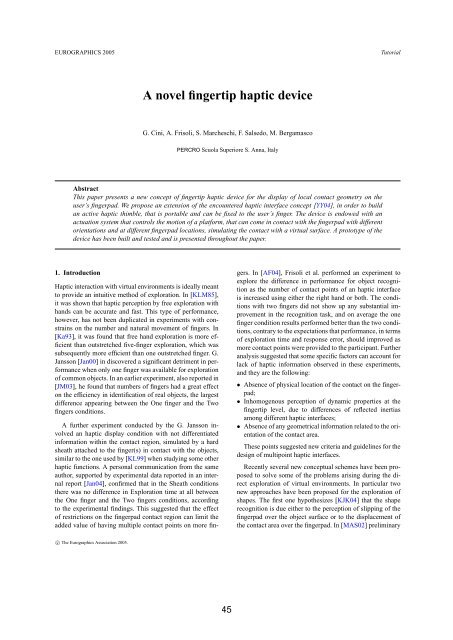full Paper - Nguyen Dang Binh
full Paper - Nguyen Dang Binh
full Paper - Nguyen Dang Binh
Create successful ePaper yourself
Turn your PDF publications into a flip-book with our unique Google optimized e-Paper software.
EUROGRAPHICS 2005 Tutorial<br />
A novel fingertip haptic device<br />
G. Cini, A. Frisoli, S. Marcheschi, F. Salsedo, M. Bergamasco<br />
PERCRO Scuola Superiore S. Anna, Italy<br />
Abstract<br />
This paper presents a new concept of fingertip haptic device for the display of local contact geometry on the<br />
user’s fingerpad. We propose an extension of the encountered haptic interface concept [YY04], in order to build<br />
an active haptic thimble, that is portable and can be fixed to the user’s finger. The device is endowed with an<br />
actuation system that controls the motion of a platform, that can come in contact with the fingerpad with different<br />
orientations and at different fingerpad locations, simulating the contact with a virtual surface. A prototype of the<br />
device has been built and tested and is presented throughout the paper.<br />
1. Introduction<br />
Haptic interaction with virtual environments is ideally meant<br />
to provide an intuitive method of exploration. In [KLM85],<br />
it was shown that haptic perception by free exploration with<br />
hands can be accurate and fast. This type of performance,<br />
however, has not been duplicated in experiments with constrains<br />
on the number and natural movement of fingers. In<br />
[Ka93], it was found that free hand exploration is more efficient<br />
than outstretched five-finger exploration, which was<br />
subsequently more efficient than one outstretched finger. G.<br />
Jansson [Jan00] in discovered a significant detriment in performance<br />
when only one finger was available for exploration<br />
of common objects. In an earlier experiment, also reported in<br />
[JM03], he found that numbers of fingers had a great effect<br />
on the efficiency in identification of real objects, the largest<br />
difference appearing between the One finger and the Two<br />
fingers conditions.<br />
A further experiment conducted by the G. Jansson involved<br />
an haptic display condition with not differentiated<br />
information within the contact region, simulated by a hard<br />
sheath attached to the finger(s) in contact with the objects,<br />
similar to the one used by [KL99] when studying some other<br />
haptic functions. A personal communication from the same<br />
author, supported by experimental data reported in an internal<br />
report [Jan04], confirmed that in the Sheath conditions<br />
there was no difference in Exploration time at all between<br />
the One finger and the Two fingers conditions, according<br />
to the experimental findings. This suggested that the effect<br />
of restrictions on the fingerpad contact region can limit the<br />
added value of having multiple contact points on more fin-<br />
c○ The Eurographics Association 2005.<br />
45<br />
gers. In [AF04], Frisoli et al. performed an experiment to<br />
explore the difference in performance for object recognition<br />
as the number of contact points of an haptic interface<br />
is increased using either the right hand or both. The conditions<br />
with two fingers did not show up any substantial improvement<br />
in the recognition task, and on average the one<br />
finger condition results performed better than the two conditions,<br />
contrary to the expectations that performance, in terms<br />
of exploration time and response error, should improved as<br />
more contact points were provided to the participant. Further<br />
analysis suggested that some specific factors can account for<br />
lack of haptic information observed in these experiments,<br />
and they are the following:<br />
• Absence of physical location of the contact on the fingerpad;<br />
• Inhomogenous perception of dynamic properties at the<br />
fingertip level, due to differences of reflected inertias<br />
among different haptic interfaces;<br />
• Absence of any geometrical information related to the orientation<br />
of the contact area.<br />
These points suggested new criteria and guidelines for the<br />
design of multipoint haptic interfaces.<br />
Recently several new conceptual schemes have been proposed<br />
to solve some of the problems arising during the direct<br />
exploration of virtual environments. In particular two<br />
new approaches have been proposed for the exploration of<br />
shapes. The first one hypothesizes [KJK04] that the shape<br />
recognition is due either to the perception of slipping of the<br />
fingerpad over the object surface or to the displacement of<br />
the contact area over the fingerpad. In [MAS02] preliminary
















